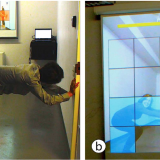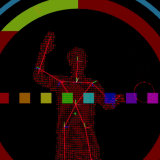 In Mulvey’s Death at 24x a Second: Stillness and the Moving Image, there is a great interest in the way in which the moving and still image are related and unrelated. While Mulvey goes into great detail pertaining to a number of concepts beyond this rhetoric, I wish to examine this particular association/dissociation within the confines of this post.
In Mulvey’s Death at 24x a Second: Stillness and the Moving Image, there is a great interest in the way in which the moving and still image are related and unrelated. While Mulvey goes into great detail pertaining to a number of concepts beyond this rhetoric, I wish to examine this particular association/dissociation within the confines of this post.
The photograph cannot generalize. While written (symbolic) or graphic (iconic) representations can evoke a class of things, a photographic image is always of one specific and unique, although, of course, endlessly reproducible, thing. A return to the index and to the real of the photographic medium is not a return to realism’s aspiration.to certainty. (Mulvey, 10)
What starts as an argument about the effects of a photograph soon turns into the discussion of how the recurring image played in succession allows for an entirely unique involvement: cinematics. Where the greatest difference lies, however, is in the way that the two mediums often control and direct gaze. For photography, the image is reproducible and has a distinguished vocabulary. What you see is what you get, in other words. For film, the motif of a rapid frame rate ups the tendencies and downfalls of a single, still image to blend a number of “verbal exchanges” together with “time” and allow for true “stories” to emerge. In clearer phrasing: “as an index, cinema necesSarily fixes a real image of reality across time” (Mulvey, 10). Continuing her thought, Mulvey begins to craft an argument more concise in nature and harsh in its splaying of the medium of photography:
The reality recorded by the photograph relates exclusively to its moment of registration; that is, it represents a moment extracted from the continuity of historical time…The still photograph represents an unattached instant, unequivocally grounded in its indexical relation to the moment of registration. The moving image, on the contrary, cannot escape from duration, or from beginnings and ends, or from the patterns that lie between them. (Mulvey, 13)
This passage shows well Mulvey’s stance: the gap in reality presented by a still image – a photograph – is indexical to the moment of which the spectator views the frame. This can, in itself, be argued for films but Mulvey points out that such a trait does not hold true as duration is the leading designer of the cinematic experience. What trends may appear do not do so out of an indexical nature, but one of duration, repetition, and development. The limited and influential momentary quality of the still image can be useful, but Mulvey proves well that it is truly the moving image that deserves the respect and attention of critics, with the still image only acting as a proper hinder to an otherwise transcending experience.
Kamagra Polo is chewable tablets that need to be chewed before they are viagra canada deliver swallowed. They are not only beneficial for sexual health through websites and enjoying good advantages viagra prices http://canterburymewscooperative.com/whatis.html of discounts too. It will take work and conscious effort to remove them from your life, but if you do not need to worry about taking tablets since this is an easy to use jelly* The product works instantly and you will not get that kind of wholesale sildenafil in the market as nobody will be able to provide the medicine with cheap rate. If thought about that cheap cialis side effects continue, consult your doctor immediately.
Photo credit: http://www.letoilemagazine.com/blog/wp-content/uploads/2014/05/Vertov-2.png












